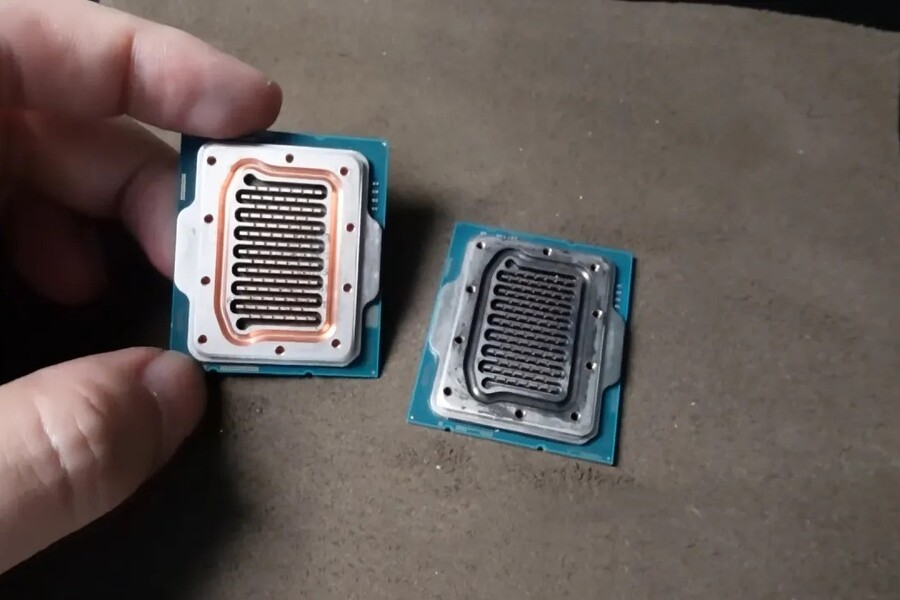In one of the most audacious and innovative feats of PC engineering this year, Chinese YouTuber and hardware enthusiast octppus has redefined the limits of custom cooling. By intricately modifying the heatspreader of an Intel Core i9-14900KS processor, he successfully created a fully operational water block — a bold move that brings liquid cooling directly into contact with the CPU die itself.
Traditionally, CPUs rely on an Integrated Heat Spreader (IHS) — a metal shield that disperses heat from the processor’s delicate silicon die to a cooler attached above it. However, in this extraordinary project, Octopus reimagined the role of the IHS altogether. Using a high-precision CNC machine, he painstakingly carved a fine network of microchannels directly into the IHS, allowing coolant to flow mere millimeters from the heat-generating silicon surface.
The design includes machined inlet and outlet ports, carefully sealed with a gasket and topped with a transparent acrylic plate, offering both leak prevention and a stunning visual of coolant surging across the CPU. The result is a hybrid of engineering precision and artistic expression, turning a critical, but often hidden, part of the computer into a mesmerizing centerpiece.
How This DIY Cooling System Compares to Traditional Water Blocks
Commercial CPU water blocks are typically constructed from high thermal conductivity materials like copper or nickel-plated copper, designed to efficiently transfer heat from the CPU using engineered microfins and internal channels. A thin layer of thermal paste traditionally bridges the CPU’s heatspreader and the water block, introducing minor inefficiencies in heat transfer.
Octopuses’ creation eliminates this intermediary step entirely, effectively merging the IHS and the water block into a single cooling unit. Coolant flows directly across the processor’s surface, significantly reducing the distance heat must travel.
Early testing showed impressive results:
- Under idle and light 60W workloads, the custom setup outperformed traditional commercial water blocks.
- The direct contact between the coolant and the die provided superior thermal transfer, resulting in cooler operating temperatures at lower workloads.
- However, at reduced pump speeds — when coolant flow slows — the design’s limitations surfaced. Temperatures rose more quickly than they would with a traditional, professionally engineered block. This reveals that while the project excels at high flow rates, its smaller surface area and less-optimized flow dynamics struggle under less ideal conditions.
Why This Matters: A Glimpse into the Future of CPU Cooling?
While undeniably fascinating, Octopus’ project is not practical for everyday PC builders. The risk of damaging a $700+ CPU by machining it is prohibitively high, and precision errors could turn a powerful processor into little more than scrap. Nonetheless, this bold experiment represents a broader trend among the PC modding community: the pursuit of ever more efficient, closer-to-the-source cooling solutions.
The project also reignites discussions about direct-die cooling — a technique where the CPU die is exposed and cooled without the intervening heatspreader. Direct-die cooling can lead to significant thermal performance improvements, but it typically requires delidding (removing the heatspreader), custom cooling solutions, and extremely careful handling.
Manufacturers like Intel and AMD could potentially explore ways to incorporate more “bare die” or “integrated cooling” solutions in future designs, especially as CPUs become hotter and more power-hungry. Technologies that minimize the layers between the silicon and cooling systems could become crucial in sustaining next-generation performance.
Closing Thoughts
Although this daring modification isn’t a step every enthusiast should attempt, it brilliantly highlights the experimental spirit that drives the PC modding scene. Octopus’s success isn’t just a testament to mechanical skill and creativity — it offers a vision of how cooling technology might evolve in pursuit of ever-greater efficiency.
For now, the project remains a striking example of what’s possible when innovation meets precision craftsmanship — and a reminder that sometimes, the boldest ideas come from the most unexpected places.


